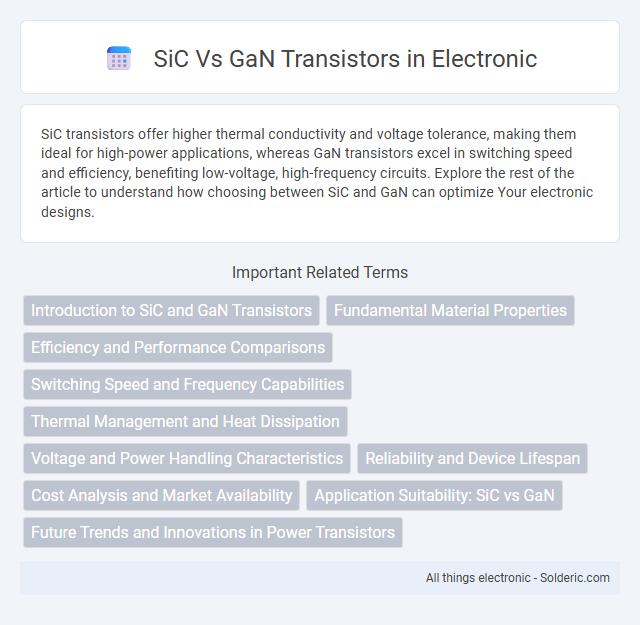SiC transistors offer higher thermal conductivity and voltage tolerance, making them ideal for high-power applications, whereas GaN transistors excel in switching speed and efficiency, benefiting low-voltage, high-frequency circuits. Explore the rest of the article to understand how choosing between SiC and GaN can optimize Your electronic designs.
Comparison Table
| Feature | SiC Transistors | GaN Transistors |
|---|---|---|
| Material | Silicon Carbide (SiC) | Gallium Nitride (GaN) |
| Voltage Rating | Up to 1700V and beyond | Typically up to 650V, some models 900V+ |
| Switching Speed | Fast, but slower than GaN | Extremely fast switching capabilities |
| On-Resistance (RDS(on)) | Moderate | Lower than SiC in low-voltage ranges |
| Thermal Conductivity | High (approx. 3.7 W/cm*K) | Lower than SiC (approx. 1.3 W/cm*K) |
| Operating Temperature | Up to 175degC+ | Up to 150degC |
| Applications | High-voltage power supplies, EV inverters, industrial motor drives | Fast switching power supplies, RF amplifiers, low-voltage DC-DC converters |
| Cost | Generally higher due to manufacturing complexity | Relatively lower cost for low to medium voltage |
Introduction to SiC and GaN Transistors
SiC (Silicon Carbide) and GaN (Gallium Nitride) transistors are advanced semiconductor devices designed for high-efficiency power electronics. SiC transistors excel in high voltage and temperature applications, providing superior thermal conductivity and robustness, whereas GaN transistors offer higher electron mobility and faster switching speeds ideal for high-frequency operations. Both technologies significantly enhance power conversion efficiency in electric vehicles, renewable energy systems, and RF amplifiers.
Fundamental Material Properties
Silicon Carbide (SiC) transistors exhibit a wide bandgap of approximately 3.26 eV, high thermal conductivity around 3.7 W/cm*K, and a high breakdown electric field near 3 MV/cm, enabling superior high-voltage and high-temperature performance. Gallium Nitride (GaN) transistors have a bandgap of about 3.4 eV, thermal conductivity near 2.3 W/cm*K, and an even higher breakdown field exceeding 3.3 MV/cm, allowing for faster switching speeds and higher frequency operation. The intrinsic properties of SiC favor robust power handling and thermal stability, whereas GaN excels in high-frequency efficiency and miniaturized power electronics.
Efficiency and Performance Comparisons
SiC transistors exhibit higher efficiency in high-voltage applications due to their superior thermal conductivity and breakdown voltage, enabling faster switching speeds with lower losses. GaN transistors outperform SiC in high-frequency operations, offering enhanced performance and reduced gate charge, which leads to higher power density and efficiency in compact, low-voltage systems. The choice between SiC and GaN depends on application-specific requirements for voltage, frequency, and thermal management to optimize overall power conversion efficiency and system performance.
Switching Speed and Frequency Capabilities
SiC transistors exhibit slower switching speeds compared to GaN transistors, typically operating effectively up to a few hundred kilohertz, while GaN transistors support switching frequencies in the megahertz range due to their lower parasitic capacitances and higher electron mobility. GaN devices deliver superior performance in high-frequency applications such as RF amplifiers and power converters by minimizing switching losses and enabling compact designs. SiC transistors, despite their lower frequency capability, are preferred in high-voltage, high-power environments because of better thermal conductivity and robustness.
Thermal Management and Heat Dissipation
SiC transistors excel in thermal management due to their higher thermal conductivity, allowing efficient heat dissipation and enabling operation at elevated temperatures up to 175degC or more. GaN transistors, while offering faster switching speeds and higher electron mobility, have lower thermal conductivity, requiring advanced cooling solutions to maintain performance and reliability. Your system's thermal design must consider these differences to optimize performance and prevent overheating in high-power applications.
Voltage and Power Handling Characteristics
SiC transistors offer superior voltage handling capabilities, typically supporting breakdown voltages exceeding 1,200V, making them ideal for high-power, high-voltage applications such as electric vehicle inverters and industrial motor drives. GaN transistors excel in high-frequency power conversion with lower on-resistance and faster switching speeds, but generally operate at lower voltage ranges, often up to 650V. Your choice depends on whether the application prioritizes ultra-high voltage durability (SiC) or efficient high-frequency performance (GaN).
Reliability and Device Lifespan
Silicon Carbide (SiC) transistors exhibit superior reliability and longer device lifespan compared to Gallium Nitride (GaN) transistors, thanks to their robust crystal structure and higher thermal conductivity. SiC's ability to withstand high temperatures and harsh operating conditions reduces degradation and failure rates, making it ideal for demanding power applications. Choosing SiC devices can enhance Your system's durability and reduce maintenance costs over time.
Cost Analysis and Market Availability
Silicon Carbide (SiC) transistors generally have higher initial costs compared to Gallium Nitride (GaN) transistors due to more complex manufacturing processes and substrate expenses. GaN transistors benefit from lower production costs and greater market availability, driven by widespread adoption in high-frequency and low-voltage applications. While SiC dominates in high-power, high-temperature markets such as electric vehicles and industrial drives, GaN gains traction in consumer electronics and telecommunications due to cost efficiency and scalable supply chains.
Application Suitability: SiC vs GaN
SiC transistors excel in high-power, high-voltage applications such as electric vehicle inverters and industrial motor drives due to their superior thermal conductivity and robustness. GaN transistors are ideal for high-frequency, fast-switching applications like RF amplifiers and power supplies in consumer electronics, offering higher efficiency and smaller form factors. Your choice between SiC and GaN should depend on the specific power, frequency, and thermal requirements of your application.
Future Trends and Innovations in Power Transistors
SiC and GaN transistors are driving future trends in power electronics due to their superior efficiency, thermal conductivity, and switching speeds compared to silicon counterparts. Innovations focus on enhancing device robustness, integrating advanced packaging techniques, and scaling for higher voltage and current applications in electric vehicles, renewable energy, and 5G infrastructure. Research is also targeting hybrid SiC-GaN systems to leverage the benefits of both materials, enabling unprecedented power density and reliability in next-generation power converters.
SiC vs GaN transistors Infographic

 solderic.com
solderic.com